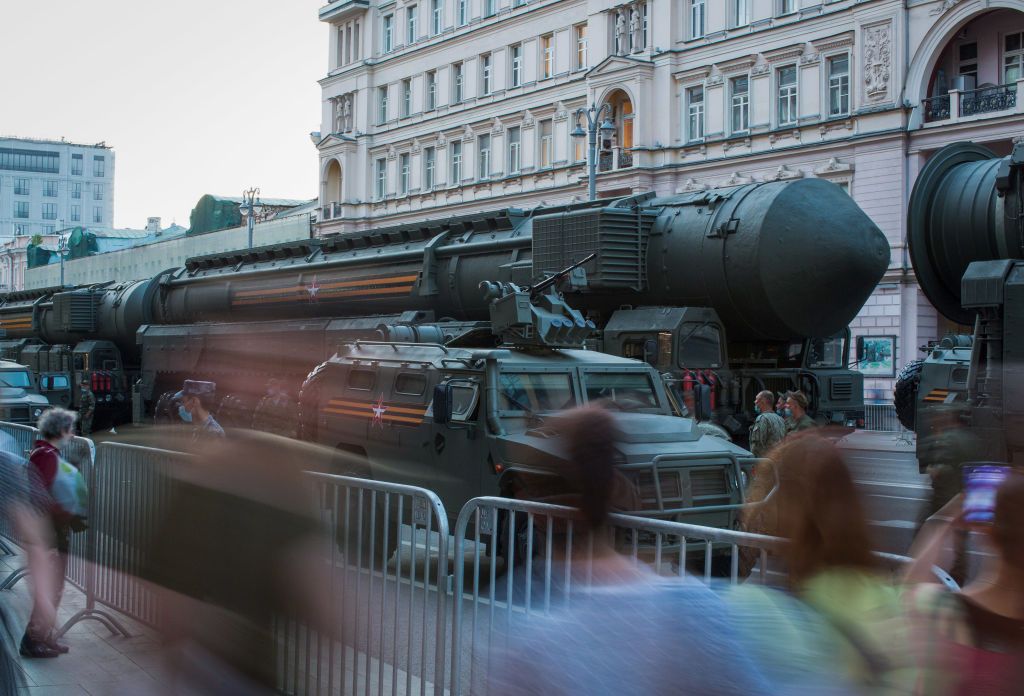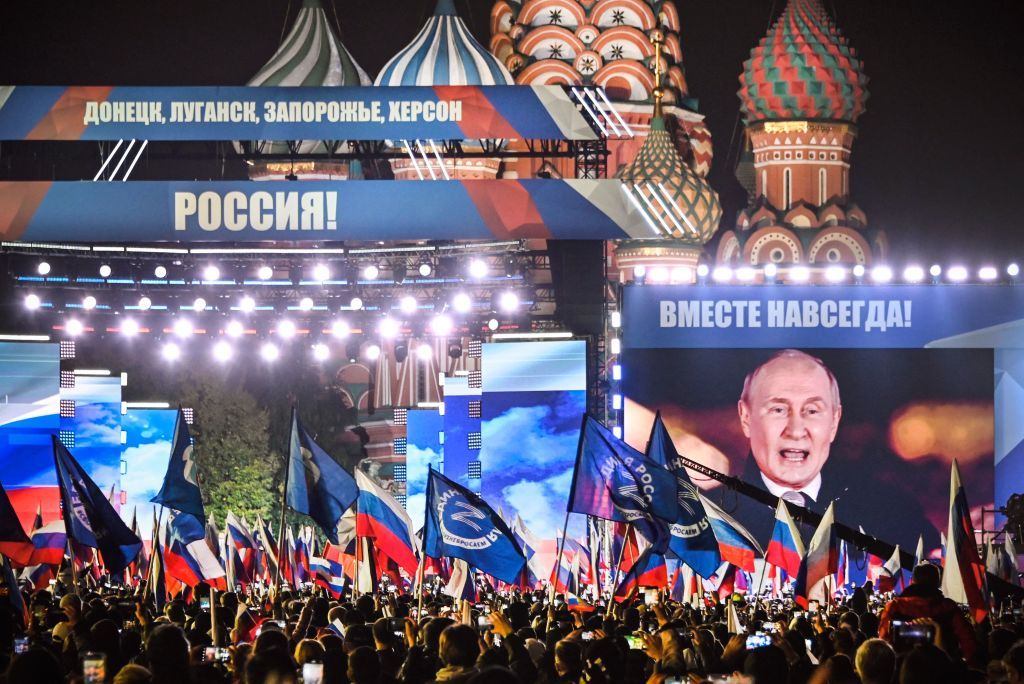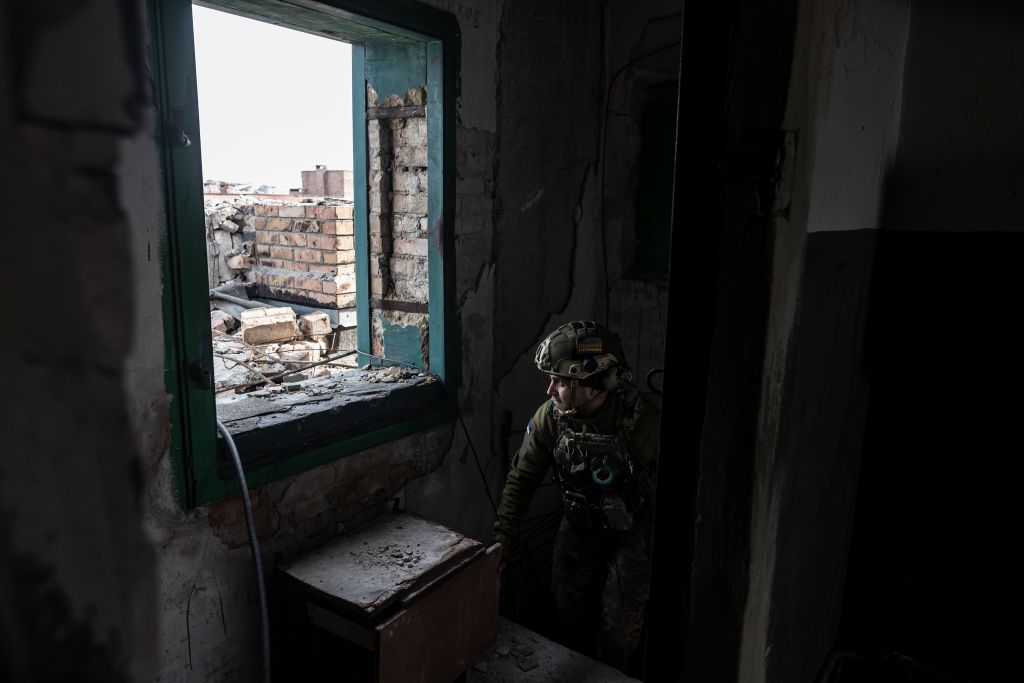
The main rule of Russia's power diplomacy says: If something goes wrong with their war effort in Ukraine, reach for the nuclear intimidation card.
That’s what the Kremlin did two months ago, when Vladimir Putin announced Russia would "suspend" its participation in the New START, the only remaining U.S.-Russian nuclear arms control agreement between the United States and Russia.
The announcement once again allowed the Kremlin to promote the notion that the West’s support of Ukraine is pushing the world towards a nuclear holocaust.
But despite all the noise, this threat from Russia has had little to no effect on the global nuclear posture.
The suspension of the deal has effectively given the Kremlin just one thing: a quasi-legitimate reason to terminate mutual inspections of nuclear stockpiles, an essential part of the New START signed in 2010.
In the last three years, Russia has been seeking to keep American inspectors away. And the reason behind that is likely not Moscow's eagerness to bolster nuclear power but rather the opposite – hiding the scale of its nuclear arsenal’s reduction. The Russian nuclear stockpile has been gradually dwindling for years.
Older delivery systems and warheads produced decades ago are naturally running out of their operational lifetime. And today's production of new missiles, strategic bombers, or nuclear-carrying submarine systems is not strong enough to compensate for the reduction.
According to experts, the decommissioning of Russian nuclear weapons started and will continue until at least the 2030s. But admitting this decline is impossible for the Kremlin, which puts nuclear weapons at the center of its intimidation efforts and war propaganda, both domestic and international.
Due to the lack of on-site inspections, there’s little certainty regarding how much of the nuclear power that Russia claims as deployed is actually operational.
The U.S. and the international community still have ways to get estimated data on the state of the Russian stockpile.
But behind this opaqueness, the Kremlin can go on imitating parity with the U.S. or even claim nuclear buildup, increasing the risk of a new nuclear arms race. And it will likely continue using this lack of nuclear transparency for rendering pressure upon the West, including on things like Western support of Ukraine in the war.
 Kyiv IndependentKatie Marie Davies
Kyiv IndependentKatie Marie Davies
Treaty on the rocks
The New START (Strategic Arms Reduction Treaty) was the third in a series of Russian-American agreements to reduce both nations' gargantuan late Cold War-time nuclear arsenals and bolster mutual trust.
The treaty came into force in 2011. It set several limits for the U.S. and Russia’s arsenals.
According to the treaty, neither party must can possess more than a total of 700 intercontinental ballistic missiles (ICBM), submarine-launched ballistic missiles (SLBM), and heavy bombers — all deployed and carrying nuclear armaments; no more than 1,550 nuclear warheads can be deployed on the mentioned delivery vehicles; and no more than 100 additional nuclear-equipped missiles and bombers carrying nukes but non-deployed are allowed.
For comparison, in the early 1980s the Soviet Union and the U.S each had over 2,000 nuclear delivery systems and over 10,000 warheads deployed, along with tens of thousands of warheads in store.
According to estimates by the Federation of American Scientists (FAS), thanks to years of arms reduction effort, the global amount of nuclear weapons dropped from 70,300 in 1986 to 12,500 in early 2023, or by over 80%.
The New START reduction was to be completed within the next seven years, by 2018.
Mutual inspections and communication were essential to the successful implementation of the treaty.
Both nations were entitled to inspect each other's nuclear installations yearly and had to notify each other about missile test launches and the status of their stockpiles on a regular basis.
The New START, however, does not cover low-yield tactical nuclear weapons or retired nuclear warheads meant for disposal.
In a way, the treaty was beneficial to Russia. By the time the New START was signed, the number of delivery systems Russia was deploying was below the limit (611 against the maximum of 700), although it had to retire a number of extra warheads.
This meant that Russia could even increase the number of missiles and bombers deployed. And it could safely enjoy nuclear parity with the U.S., without spending resources on unveiling new weapons.
Despite fierce Republican opposition, the administration of U.S. President Joe Biden in early 2021 extended the treaty until 2026.
As of late March 2023, according to estimates by the Federation of American Scientists, Russia had 1,674 strategic warheads deployed and ready for use.

Additionally, it’s estimated to have 2,815 warheads that are in reserve, non-deployed, and possibly tactical. More than 1,400 warheads are believed to be retired and non-functional.
In turn, the United States has almost the same number of strategic warheads deployed — 1,670. That goes along with some 100 non-strategic munitions (likely B61 gravity nuclear bombs deployed to U.S. bases in Europe), as well as 1,938 reserve and 1,536 retired warheads.
Combined, the two nations are responsible for a total of nearly 11,133 warheads, which includes deployed, non-deployed, and retired munitions. That’s 86% of the global inventory of stockpiled warheads available for military use and 89% of the world's overall nuclear arsenal, according to FAS figures.
Upon the Federation of American Scientists’ estimates, the deployed Russian warhead stockpile, as well as the American one, remain at the parity level. Although they somewhat exceed the New START threshold, as judged from the charts.
The federation specifically notes that its estimates go with “significant uncertainty” as both the U.S. and Russia now do not exchange data or publicly disclose any information regarding its nuclear stockpiles.
According to the U.S. Department of the State, in its latest notification dated September 2020, Russia declared having 1,447 deployed strategic warheads, which corresponds to the New START threshold.
Those are the numbers on paper.
But when it comes to more detailed information on the condition of warheads, as well as the quantity of intercontinental ballistic missiles, bombers, and submarines that carry them, there's a barely penetrable smokescreen.
 Kyiv IndependentFrancis Farrell
Kyiv IndependentFrancis Farrell
No inspections
Over the last three years, the Kremlin has been looking for any possible reason to get rid of on-site inspections of its nuclear arsenal.
They were initially halted in 2020 due to the Covid-19 pandemic. Russia was only meeting its part of the treaty by sending a report on its nuclear stockpile to the U.S. every six months.
Amid growing tensions regarding Russia's massive military buildup in 2021, Russia also declined American access under the pretext of quarantine restrictions.
In the summer of 2022, following the start of Russia's full-scale war in Ukraine, Russia declined an inspection again, saying that due to Western sanctions, Russian delegations can't travel to the U.S. via European nations to do their inspections (despite Russia and the U.S. having a common maritime border at Alaska).
In late 2022, Moscow again postponed a New START commission meeting in Cairo.
The Russian Foreign Ministry spokesperson Maria Zakharova explained this as a "political decision" made by the Kremlin due to "the highest level of toxicity and hostility" coming from the U.S. that, in her words, waged a "total hybrid war on Russia."
The U.S. Department of State has repeatedly called on Moscow to reinstate the mutual on-site inspections — and said nothing prevented Russian envoys from visiting American nuclear arms facilities.
In late January 2023, a report issued by the Department directly accused Russia of violating the treaty for the first time.
In his address to the State Duma on Feb. 21, Putin announced Russia would be “suspending" the deal, even though the treaty bears no provision for doing so. Putin accused the West of being "directly involved" in Ukrainian attacks on Russian strategic bombers used in missile strikes upon Ukraine's critical infrastructure.
"And amid all that, (U.S. inspectors) want to cruise around at our defense facilities, including the newest ones?" Putin said without specifying any kinds of new nuclear arms sites eligible for New START inspections.
Within the next week, the Kremlin turned the “suspension” into a law passed by the Russian parliament.
Yet, almost immediately following the announcement, the Russian Defense Ministry reassured that despite the "suspension," Russia intends to stick to the New START stockpile limits.
Moreover, according to Russia's Foreign Ministry, Moscow would continue notifying the U.S. of its test launches.
In his speech at the Russian parliament on Feb. 21, Putin also issued a new threat, saying that the Russian military would resume full-fledged nuclear tests, but only if the U.S. did so first. Even though the U.S. never ratified the 1996 corresponding international treaty, the U.S. hasn't had any nuclear tests since 1992 and never voiced any intentions to resume the practice.
In fact, the whole stunt appears to have been intended to let Russia stop sharing data on its nuclear arms – and never admitting Americans to check anything on the ground.
With no on-site verification, it’s now harder to tell which Russian nuclear delivery systems are actually operational and which are unusable now – although the U.S. still has its ways to make general estimates, particularly via satellite surveillance.
The Russian military claims to operate a total of 320 intercontinental ballistic missiles, as well as 10 nuclear-armed submarines and 66 heavy bombers Tupolev Tu-160 and Tu-95MC carrying nuclear munitions.

For instance, Russia's Strategic Nuclear Forces claim to operate 46 heavy missiles R-36M2 Voyevoda (commonly known in the West under the NATO name, SS-18 Satan), which entered service in the 1970s and 1980s.
These missiles make up the bulk of Russia’s nuclear power, with one missile designed to carry up to 10 warheads with a yield of up to 1 megaton (equivalent to 1 million tons of TNT). For comparison, the bomb that was used against Hiroshima in 1945 had a yield of 16 kilotons (16,000 tons of TNT).
But the R-36M2 Voyevoda missiles are considered to have long passed their operational life, especially given the fact that most missile types are designed to sustain between 10 and 15 years of service, with the possibility of extension following test launches and checkups.
Russia has been running a program to extend the use of R-36s since as far back as 2003.
The R-36 operation and production history is closely tied to Ukraine's Yuzhnoye Design Bureau, which terminated the missile's maintenance for Russia in 2015.
In 2018 and 2019, the Kremlin again announced its plans to extend the use of R-36M2 systems. But even since then, there have been little to no test launches, which suggests that the missiles are not being extended anymore, and that there’s no certainty regarding their operational status after so many years in service.
Inevitably, the old R-36s are being gradually retired, according to Pavel Luzin, a Russia defense policy expert with the U.S.-based Fletcher School of Law and Diplomacy.
"This process began a long time ago, and it's a natural thing," the expert said.
“You can extend the use of R-36M2 on paper for as long as you want, but delivery vehicles, navigation components, propellent elements run out of their time. There is the reduction of not only missiles but, for instance, nuclear-armed submarines and even bombers. Not only R-36M2s, but also Topol and Topol-M missile systems are also being removed from service.”
And this natural reduction will inevitably continue until at least the end of the decade, the expert believes.
And besides that, Luzin added, the production of new nuclear missile systems in Russia does not keep up with the inevitable reduction.
As of now, Russia has a missile production center in Votkinsk and also a limited manufacturing capacity in Krasnoyarsk. Luzin describes the present situation as Russia “having one and a half factory” to produce intercontinental ballistic missiles.
Right now, Russia is not even close to having the manufacturing capability of the Soviet Union, which had as many as four far larger and more productive missile manufacturing centers, including the one based at the Yuzhmash in Ukraine’s Dnipropetrovsk (now Dnipro), which was responsible for nearly 50% of the Soviet nuclear power production.
Over the last few years, the Kremlin also suggested a range of new nuclear missile projects to modernize Russia's nuclear power.
The RS-28 Sarmat, one of the loudest projects of recent times, is meant to replace the old R-36M2 Voyevoda.
Presented with the Kremlin's traditionally excessive pomposity, the Sarmat missiles had only two test launches, the latest ending in failure in late February 2023 around the time President Joe Biden was in Kyiv, according to the Pentagon.
It entered serial production only as recently as late 2022. The deployment of a significant number of missiles will take years, if even possible, given Russia’s limited options for import of components and declining economy due to sanctions and furthering international isolation.
There is also the Avangard project, a glide warhead-carrying vehicle installed on old Soviet UR-100N missiles. The Russian Defense Ministry claims the system can reach a velocity of over 20 Mach, which allegedly makes it invincible to U.S. ballistic missile defense.
As of late 2022, Russia was believed to have operated only six Avangard systems since 2019.
And even at a far smaller scale as compared with the Soviet era, Moscow's nuclear missile manufacturing is still prone to the same old issue – the production for the sake of just keeping the system running, with no substantial effect on Russia’s nuclear posture.
"The Sarmat project is there just for the sake of keeping a plant in Krasnoyarsk, a construction bureau in Miass, and the production of liquid fuel engines in Perm," Luzin said.
"And Avangard is also necessary just for its designer and manufacturer to keep going. And there's (the 13th Missile Division in Orenburg) that has a few old and excessive missiles UR-100N with no warheads — so they install the Avangards… All those things should have been shut down and switched to doing much more useful things.”
Note from the author:
Hello! My name is Illia Ponomarenko, the guy who wrote this piece for you.
I hope you found it useful and interesting. I work day and night to bring you quality stories from Ukraine, where Russia is waging the biggest war in Europe since WWII. My little homeland, Donbas, is now the site of the worst fighting. We are helping to keep the world informed about Russian aggression.
But I also need help from every one of you — to support Ukrainian wartime journalism by donating to the Kyiv Independent and becoming our patron.
Together, we can help bring peace to Ukraine.
Comments
No comments yet. Be the first to react!